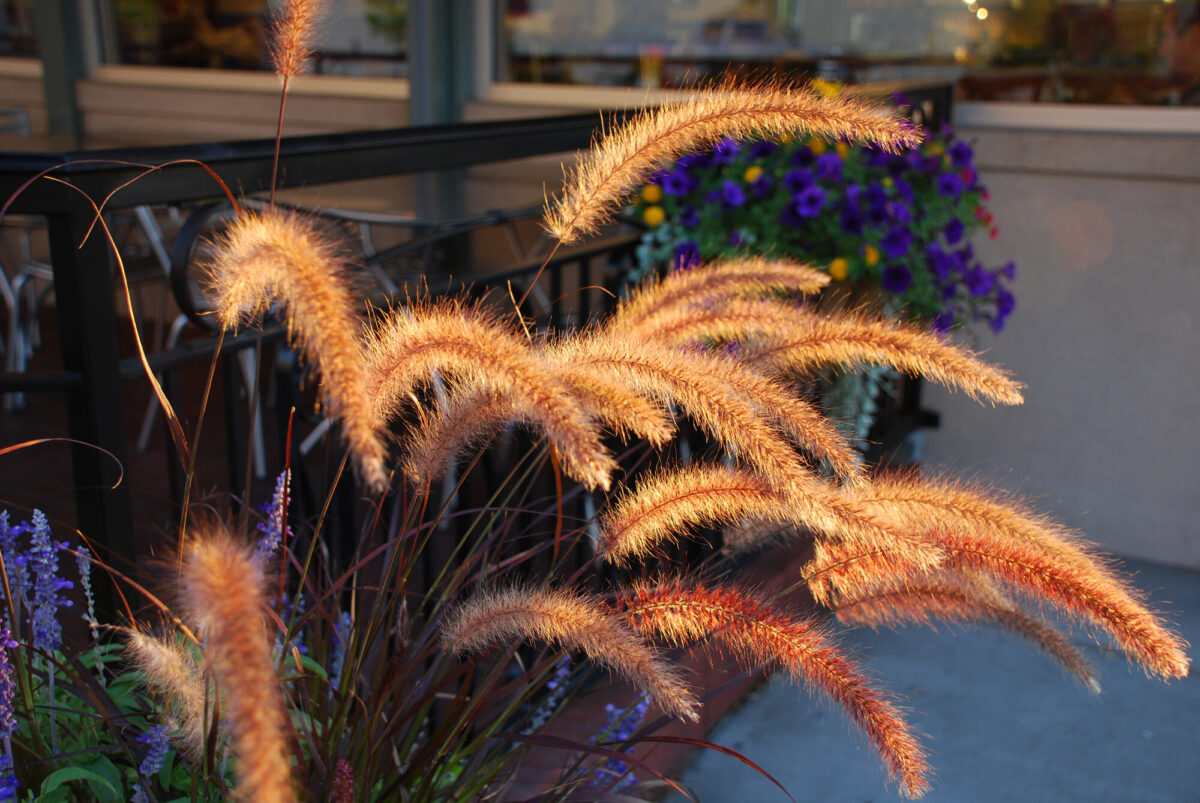Page snapshot: Introduction to ornamental grasses and their decorative, aromatic, and cultural uses.
Topics covered on this page: Introduction; Decorative ornamental grasses; Aromatic ornamental grasses; Weedy ornamental grasses; List of selected ornamental grases; Resources.
Credits: Funded by the National Science Foundation. Any opinions, findings, and conclusions or recommendations expressed in this material are those of the author(s) and do not necessarily reflect the views of the National Science Foundation. Page by Deme Burns (2023). E.J. Hermsen added selected information on grass ranges and invasiveness.
Updates: Page last updated August 31, 2023.
Image above: Red fountain grass (Pennisetum setaceum) cultivated as a decorative ornamental grass and planted with flowers on the sidewalk outside of a restaurant in order to attract customers in Billings, Montana (U.S.A.) Photo by USDA NRCS Montana (Wikimedia Commons, Public Domain. Image resized).
Introduction
An ornamental grass is a type of grass that is considered aesthetically pleasing. Ornamental grasses are cultivated for decorative or aromatic purposes instead of practical purposes. When used in landscaping, they add movement, depth, texture, and create a natural appearance. They may be used indoors, planted in ornamental gardens, used to line sidewalks, or placed around pools, parking lots, or in other urban areas.
In addition to their aesthetic appeal, ornamental grasses can have other benefits. They typically establish deeper, denser root systems than mowed lawn grasses, which can aid in erosion control. Some ornamental grasses are drought resistant and require minimal watering. They can also attract native wildlife by providing food and shelter.
This page explores common ornamental grasses and their uses.

Muhly grass (Muhlenbergia capillaris), native to parts of North America, is known for its eye-catching looks and purple hues. Photo by David J. Stang (Wikimedia Commons, Creative Commons Attribution-Share Alike 4.0 International license. Photo resized.)
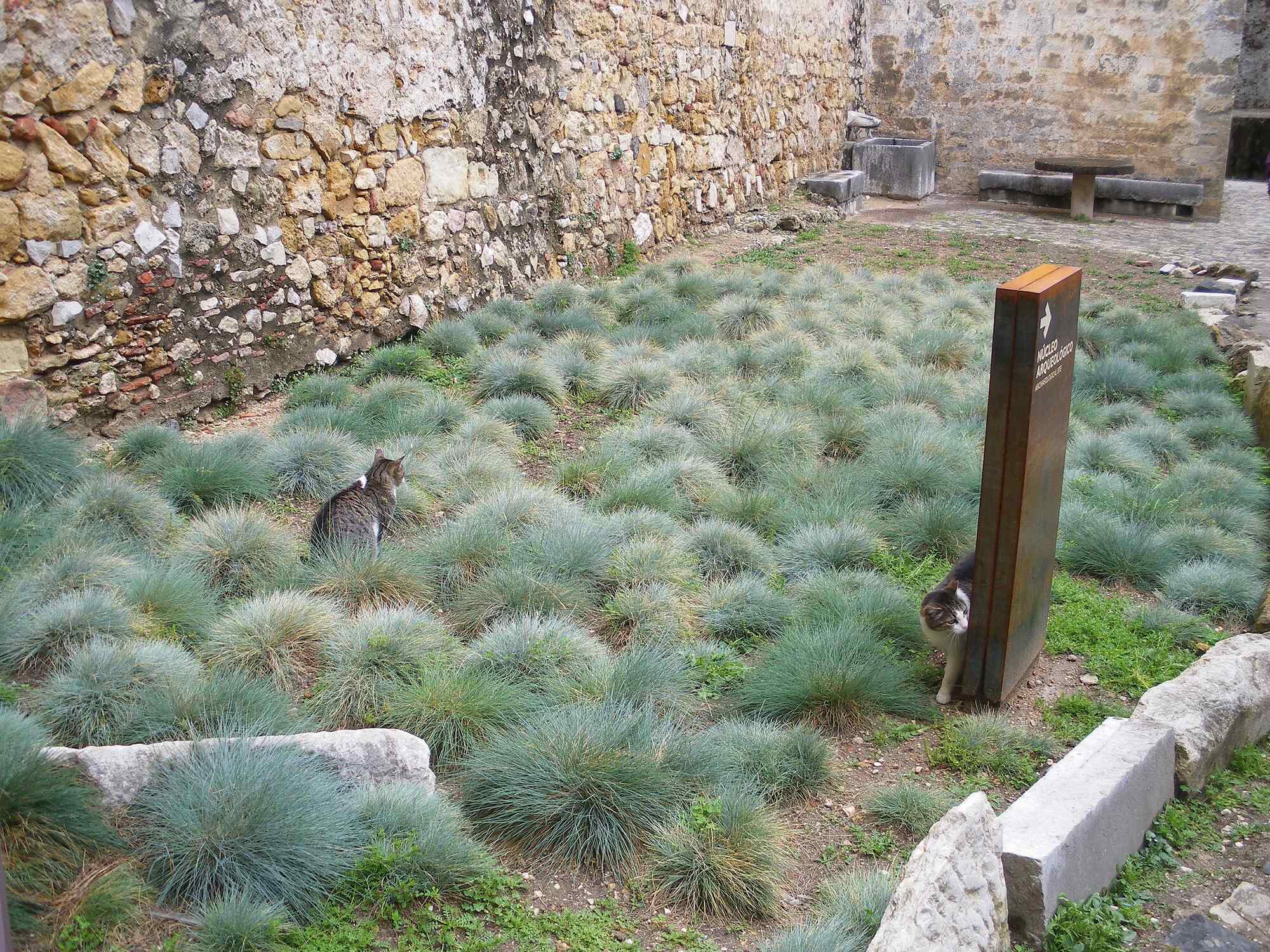
Blue fescue (Fescue glauca), native to Europe, is a blue-gray ornamental grass. It is used to accent rocks, gardens, line the exterior, and more. It has a very unique texture and color contrast that make it desirable as an ornamental. Lisbon, Portugal. Photo by Luiyo. Wikimedia Commons, Creative Commons Attribution-Share Alike 2.0 Generic license.
Decorative ornamental grasses
There are several ornamental grasses that can increase the beauty of a yard and need little maintenance. Ornamental grasses are very versatile and can look modern, formal, or or natural. Listed below are a few of the most common ornamental grasses that are used as for decorative purposes; these plants may add texture and movement to landscaping and provide visual interest:
- Bunny tails (Lagurus ovatus) have white flower heads that are soft and reminiscent of bunny fur. This grass is used as an ornamental and also dried for flower arrangements. It is native to areas of Europe, Africa, and Asia around the Mediterranean Sea.
- Fountain grasses (selected Cenchrus species, formerly Pennisetum spp.) are known for their feathery flowerheads and fountain-like growth habit. However, some species of fountain grass are invasive, and African feather grass (Cenchrus caudatus or Pennisetum macrourum) is regulated as a noxious weed in the U.S.
- Feather reed grass (Calamagrostis x acutiflora) is a clump-forming grass. It has feathery plumes that give it its name. This grass is a hybird of two Eurasian species.
- Japanese forest grass (Hakonechloa macra) is popular for its vibrant green foliage and dense, clumping appearance. As its name suggests, this grass is native to Japan.
- Blue fescue (Festuca glauca) has blue-green foliage and a fluffy appearance. It has a clumping growth habit and is often used to line edges. Blue fescue is native to Europe.
- Mexican feather grass (Nassella tenuissima) is native to Mexico, adjacent parts of the southern U.S., and parts of South America. When crushed, it is described to have a light scent.
- Muhly grass (Muhlenbergia capillaris) has a deep green color. The leaves can be up to two feet long. It has airy pink or purple flower plumes, giving it a striking visual display. This grass is native to parts of North America.
- Purple lovegrass (Eragrostis spectabilis) is valued for its purple-pink attractive seed heads. This grass is native to parts of North America.
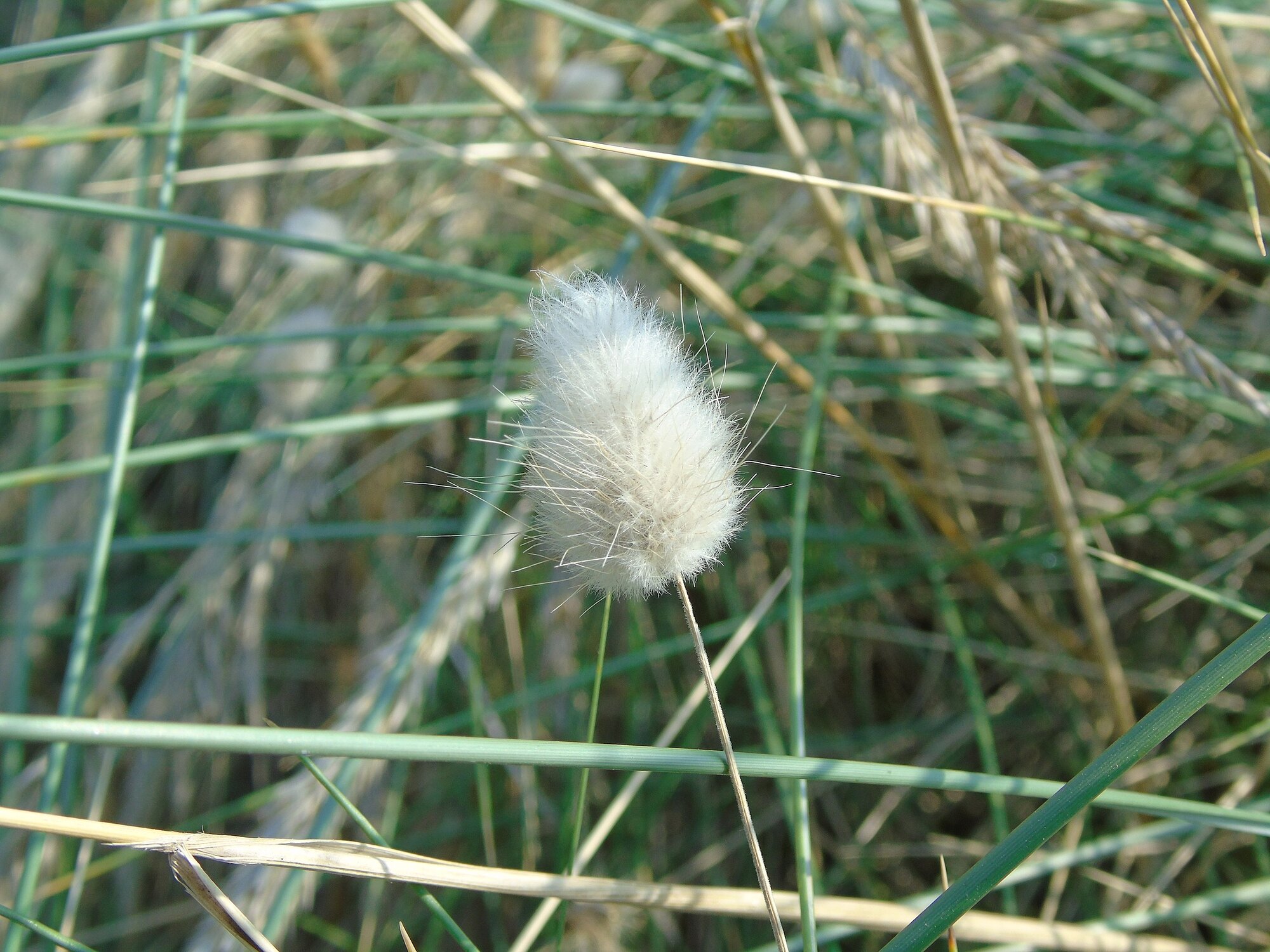
Bunny tails (Lagurus ovatus) is known for looking very similar to the tail of a rabbit. This trait makes bunny tails a popular decorative choice during Easter and represents the Easter bunny. Photo by Fernando Losada Rodriquez (Wikimedia Commons, Creative Commons Attribution 4.0 International license. Photo resized)
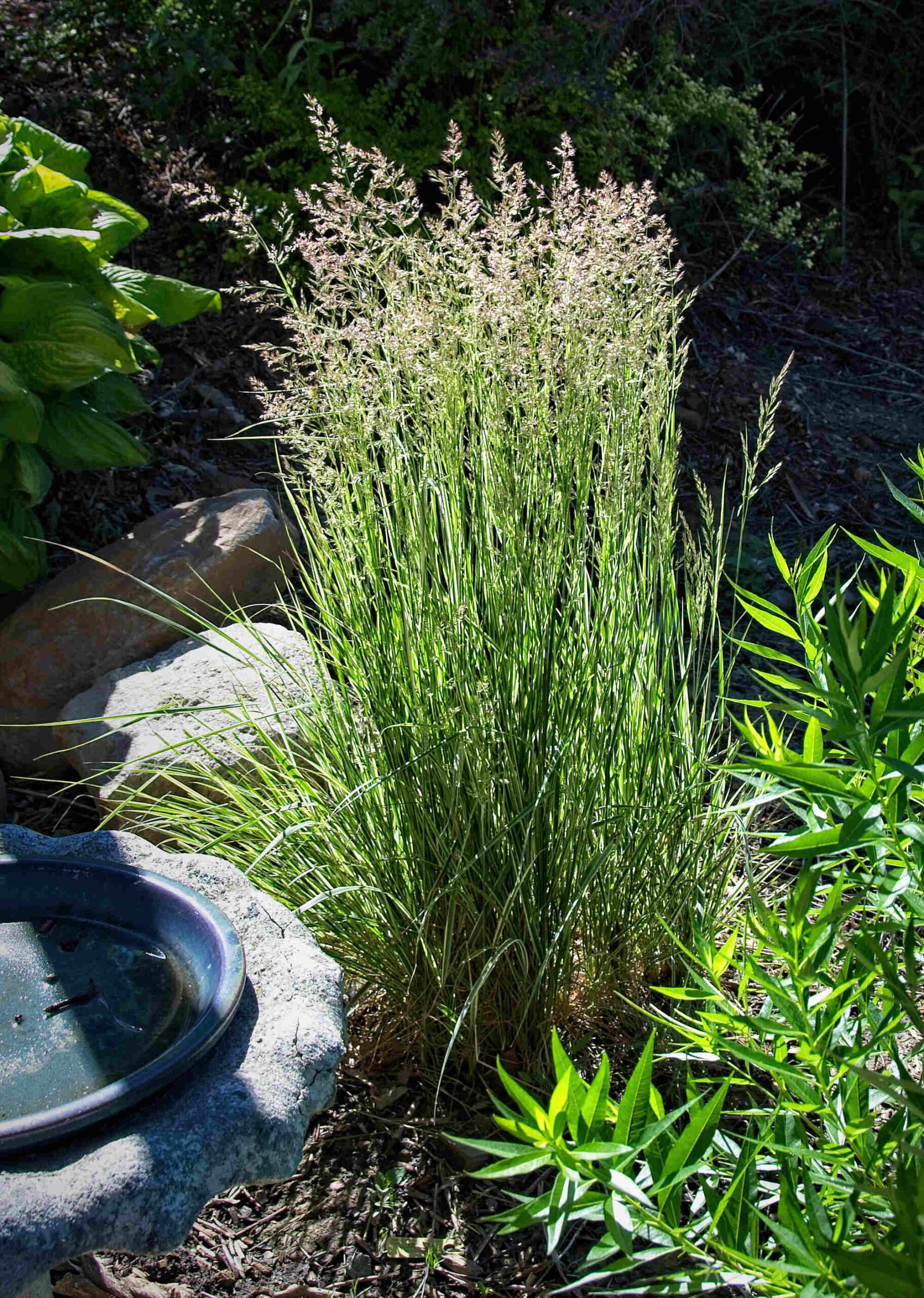
Feather reed grass (Calamagrostis x acutiflora) next to a fountain and stone. The leaf blades are very long and condensed. Photo by F. D. Richards (Wikimedia Commons, Creative Commons Attribution-Share Alike 2.0 Generic license. Photo cropped and resized.)

Japanese forest grass (Hakonechloa macra) planted along a stone sidewalk. The grass is bright green and the blades arch from the center. Photo by Katherine Wagner-Reiss. (Wikimedia Commons, Creative Commons, Attribution-Share Alike 4.0 International license. Photo resized.)

Mexican feather grass (Nassella tenuissima) decorating a path to a sidewalk. Photo by Ewen Cameron (Wikimedia Commons, Creative Commons Attribution 4.0 International license.)
Aromatic ornamental grasses
Some grasses used as ornamentals contain essential oils to give them a particular fragrance. Such grasses have traditionally been burned, crushed, and sought after for their fragrance. Today, aromatic ornamental grasses may be used to induce a sensation of relaxation, which some people may find decreases stress and anxiety. In urban areas and cities, the fragrances of ornamental grasses can invoke the feeling of being in nature. Compounds from aromatic ornamental grasses are also used in some cosmetic products and perfumes or sold as bottled essential oils that can be used in diffusers or humidifiers. Listed below are ornamental grasses that are also known for their fragrances and aromas:
- Lemongrass (Cymbopogon citratus) is known for its citrusy scent and is used in some cuisines. Most commonly used for its fragrances in southeastern Asian countries such as Thailand and Vietnam, as well as in India.
- Citronella grass (Cymbopogon nardus), which is closely related to lemongrass, has a citrus aroma and is often used as an insect repellent in tropical areas worldwide. It is native to southeast Asia.
- Vanilla grass or sweet vernal grass (Anthoxanthum odoratum or Hierochloe odorata) gives off the scent of sweet vanilla when crushed. This grass is native to Eurasia and Africa. It is considered invasive in parts of the U.S.
- Scented sweet grass (Anthoxanthum nitens) has a vanilla-like scent because it contains coumarin; it is native to large parts of North America and Eurasia.
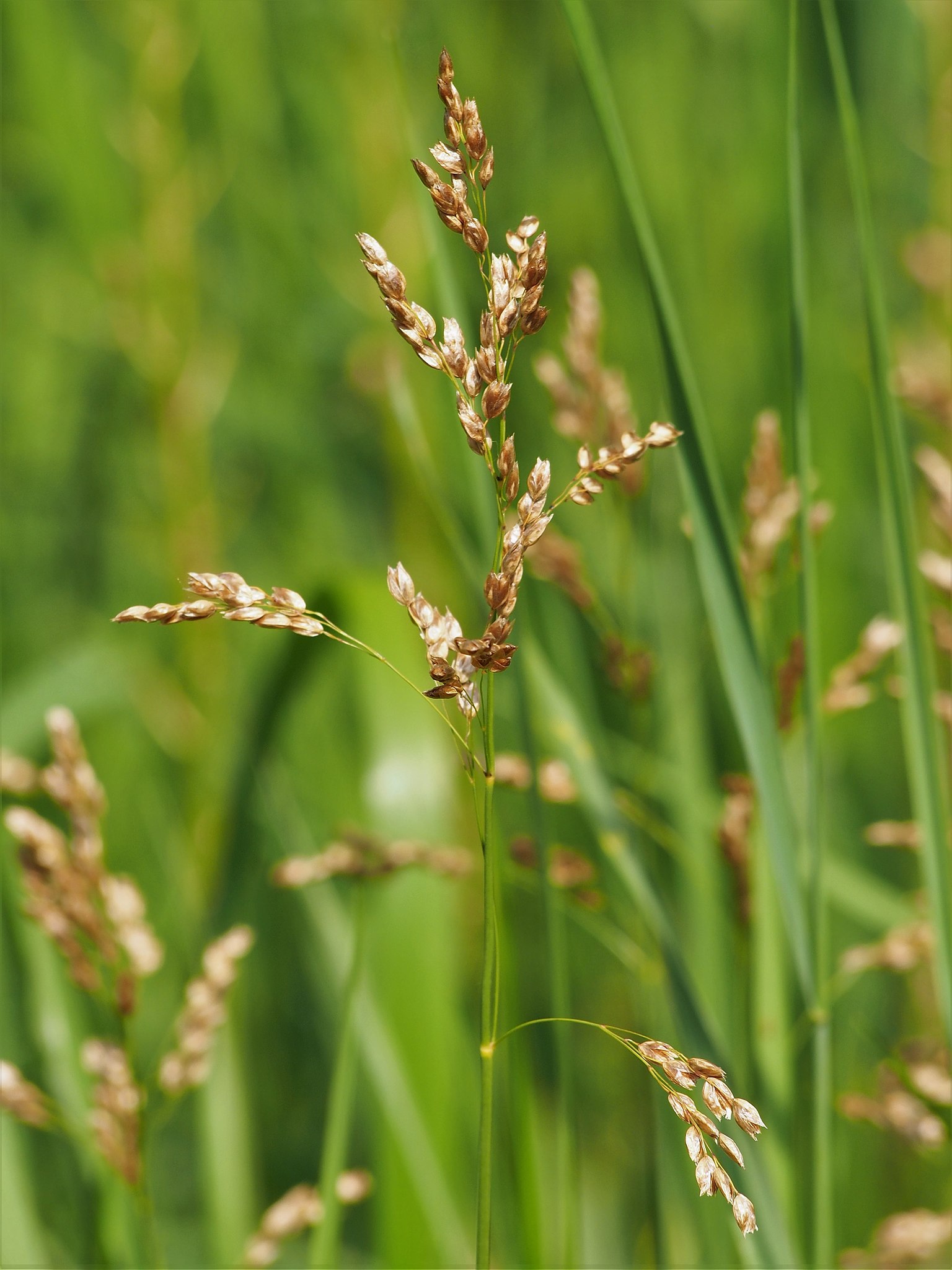
Sweet grass (Anthoxanthum odorata) is an ornamental grass known for its aroma. Photo by Agnieszka Kwiecien, Nova (Wikimedia Commons, Creative Commons Attribution 4.0 International license.)
Weedy ornamental grasses
Some ornamental grasses can become invasive and outcompete native plants, thereby disrupting local ecosystems. When considering ornamental grasses, especially ornamentals that are not native to your area, it is important to research whether they are considered invasive or potentially invasive. Examples of some ornamental grasses that have been documented as invasive are given below. Note that this list focuses on the U.S.; different species may be considered invasive in different regions of the world.
- Common reed (Phragmites australis): There are native and non-native types of common reed, and the non-native grass is considered invasive in parts of the U.S.
- Crimson fountaingrass (Cenchrus setaceus or Pennisetum setaceum): This grass grows in clumps and has attractive inflorescences. It is native to Africa and western Asia. This grass burns readily and is considered invasive in parts of the U.S.
- Giant reed (Arundo donax): Native to Asia, this impressive grass is considered invasive in parts of the U.S.
- Japanese blood grass (Imperata cylindrica 'Rubra'): This grass is a cultivar of cogongrass that has leaves with striking red tips. Cogongrass is native to Africa and western Eurasia, although it has been widely introduced elsewhere. Cogongrass is considered one of the world's ten worse weeds. This species is regulated under U.S. federal law, and its cultivation and sale have been prohibited in some states.
- Maiden grass or Chinese silvergrass (Miscanthus sinensis): This grass is prized for its graceful, arching form with light plumes on the tips. The white tips represent purity and virginity, hence the name. It comes in a variety of colors. This grass is native to eastern to southeastern Asia and is considered invasive in parts of the eastern U.S. It can invade disturbed areas and burns readily.
- Pampas grass (Cortaderia selloana): This grass forms clumps with spectacular plume-like inflorescences. Native to South America, it has been introduced widely in other parts of the world. This grass is considered invasive on the West Coast of the U.S. and in scattered other states.
- Ravenna grass (Saccharum ravennae or Tripidium ravennae): Native to Africa and Eurasia, this grass is considered invasive in parts of the U.S.
- Reed canarygrass (Phalaris arundinacea): A spreading grass that is native to large parts of the Northern Hemisphere, including North America. Neverthess, this grass is considered a noxious weed in parts of the U.S.
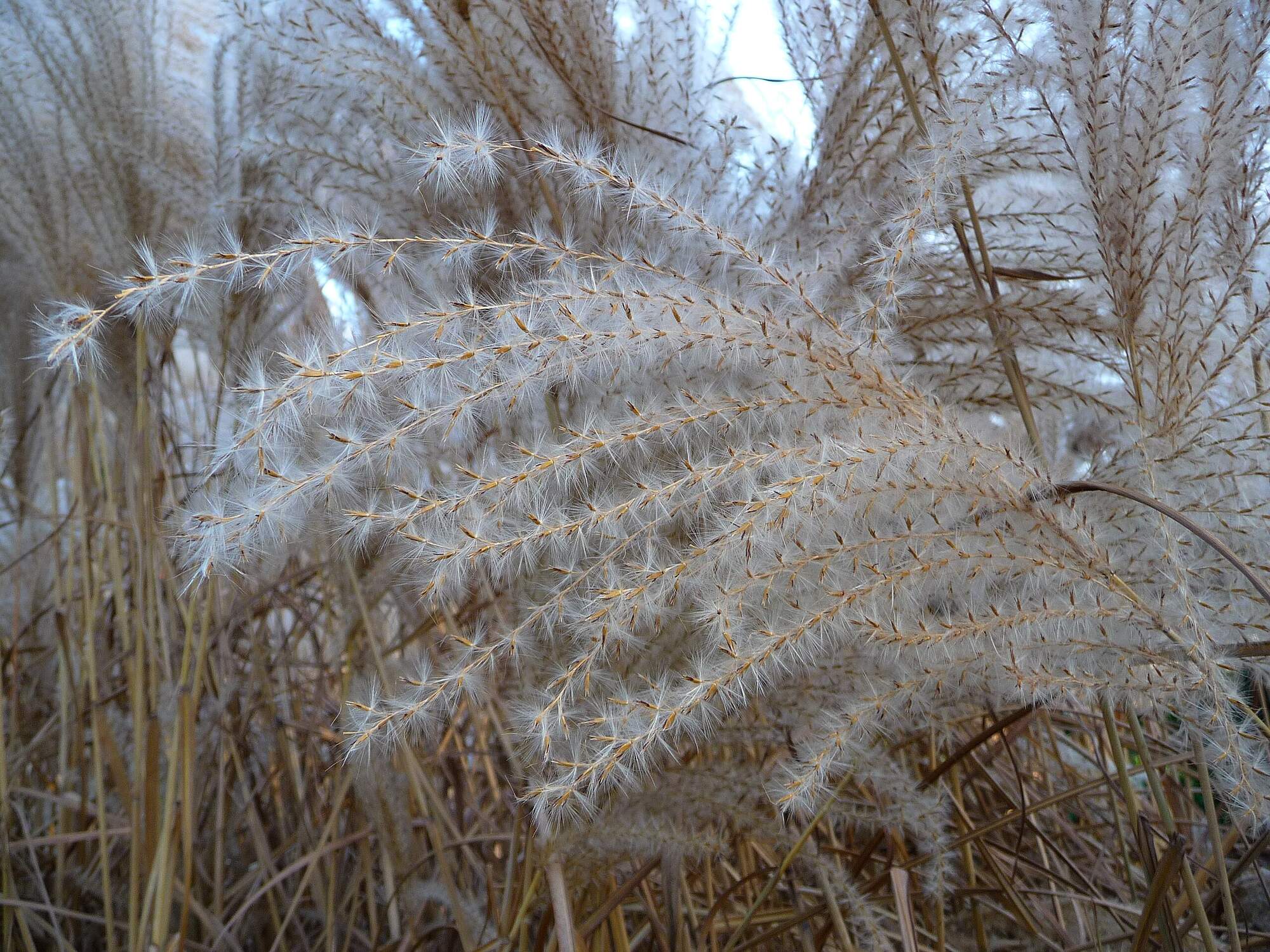
Maiden grass (Miscanthus sinensis) has a soft white texture. Photo by 4028mdk09 (Wikimedia Commons, Creative Commons CC0 1.0 Universal Public Domain)
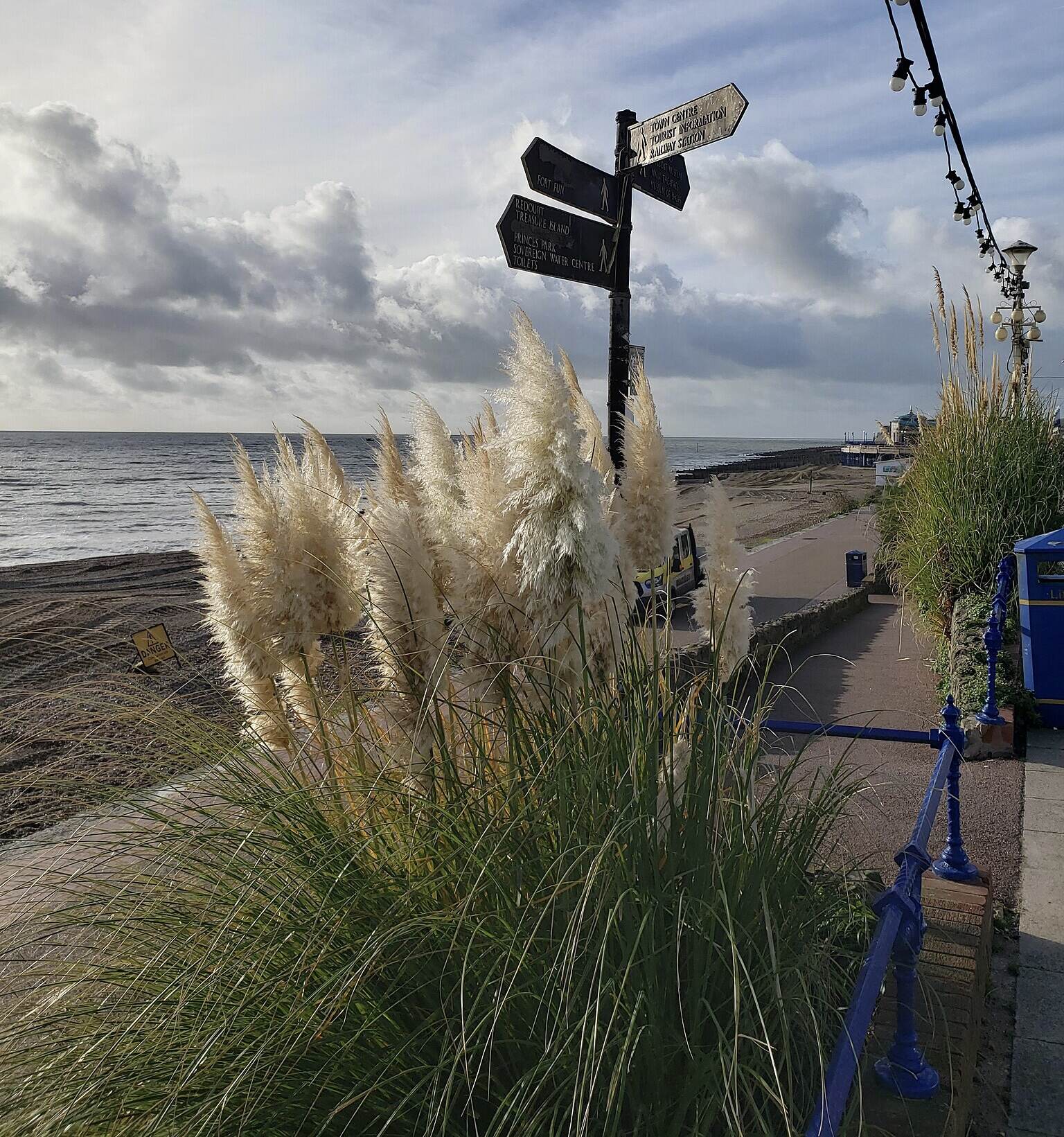
List of selected ornamental grasses
As noted above, some ornamental grasses can be invasive. It is important to research the potential impacts of non-native grasses before planting them to prevent invasive species from spreading in your area.
Warm- or cool-season ornamental grasses
Ornamental grasses either are cool-season grasses or warm-season grasses. Cool-season grasses should be planted in the fall. They begin to grow in winter and flourish in the spring and early summer. Examples include:
- Feather reed grass (Calamagrostis x acutiflora)
- Muhly grass (Muhlenbergia capillaris)
- Blue Fescue (Festuca glauca)
- Mexican feather grass (Nassella tenuissima)
Warm-season grasses should be planted in the spring. They bloom late summer and early fall. Examples include:
- Fountaingrass (Cenchrus spp. or Pennisetum spp.)
- Japanese forest grass (Hakonechloa macra)
- Switchgrass (Panicum virgatum)
- Love grass (Eragrostis spectabilis)
Annual or perennial
Annual grasses have a lifecycle that only lasts one year and they have to be replanted annually. Examples of annual ornamental grasses include:
- Lemongrass (Cymbopogon citratus)
- Fountaingrass (Cenchrus setaceus or Pennisetum setaceum), but see note about weediness above
- Foxtail millet (Setaria italica)
Perennial grasses live for multiple years without needing to be replanted. The benefits of perennial grass are that they usually have deeper root systems, which is better for erosion control. They also may require less maintenance than annuals. These are common perennial grasses:
- Blue fescue (Festuca glauca)
- Switchgrass (Panicum virgatum)
- Purple moor grass (Molinia caerulea)
- Autumn moor grass (Sesleria autumnalis)
Clumping or spreading growth habit
Spreading grasses can expand rapidly and overtake other desirable plants. If the desired ornamental grass is of the spreading variety, it is important to check whether it is an invasive species for your area.
Clumping grasses are desirable for their compact, neat, and very dense qualities, which prevent weed growth. Clumping grasses include:
- Blue fescue (Festuca glauca)
- Japanese forest grass (Hakonechloa macra)
- Blue oat grass (Helictotrichon sempervirens)
Specific ornamental features
Ornamental grasses with flowering seedheads:
- Fountain grass (Cenchrus spp. or Pennisetum spp.)
- Bunny tails (Lagurus ovatus)
Tall ornamental grasses:
- Giant miscanthus (Miscanthus x giganteus)
Ornamental grasses with vibrant colors:
- Pink foliage: Pink crystals ruby grass (Melinis nerviglumis 'Pink crystals')
- Blue foliage: Blue oat grass (Helictotrichon sempervirens)
- Purple foliage: Purple fountain grass (Cenchrus setaceus or Pennisetum setaceum), but see note about weediness above
- Silver foliage: Silver muhly grass (Muhlenbergia capillaris)
Specific environmental factors
Drought-tolerant ornamental grasses:
- Blue grama grass (Boutelous gracilis)
- Blue avena grass (Helictotrichon sempervirens)
- Purple lovegrass (Eragrostis spectabilis)
- Fountaingrass (Pennisetum spp.)
Shade-tolerant ornamental grasses:
- Tufted hair grass (Deschampsia cespitosa)
- Woodland reed grass (Calamagrostis arundinacea or Calamagrostis brachytricha)
Deer-resistant ornamental grasses:
- Little bluestem (Schizachyrium scoparium)
- Northern sea oats (Chasmanthium latifolium)
- Blue fescue (Festuca glauca)
Resources
Websites
Best ornamental grasses (Missouri Botanical Garden): https://www.missouribotanicalgarden.org/gardens-gardening/your-garden/help-for-the-home-gardener/advice-tips-resources/visual-guides/best-ornamental-grasses
Blue fescue, Festuca ovina glauca (Wisconsin Horticulture, Division of Extension): https://hort.extension.wisc.edu/articles/blue-fescue-festuca-ovina-glauca/
California Invasive Plant Council: https://www.cal-ipc.org/
Invasive Plant Atlas of the United States: https://www.invasiveplantatlas.org/index.cfm
Missouri Botanical Garden Plant Finder: https://www.missouribotanicalgarden.org/PlantFinder/PlantFinderSearch.aspx
Ornamental grasses and grass-like plants (Clemson Cooperative Extension Home & Garden Information Center Factsheet HGIC 1178): https://hgic.clemson.edu/factsheet/ornamental-grasses-and-grass-like-plants/
Ornamental grasses with fragrance (KarensGardenTips.com): https://www.karensgardentips.com/top-plant-picks-for-the-garden/grasses/ornamental-grasses-with-fragrance/
Phragmites australis australis (common reed) (USGS NAS-Nonindigenous Aquatic Species): https://nas.er.usgs.gov/queries/FactSheet.aspx?speciesID=2937
Articles & reports
Neveln, V. 2022. 15 beautiful ways to use ornamental grasses in your landscape. Better Homes & Garden, 23 August 2022. https://www.bhg.com/gardening/flowers/perennials/ways-to-use-ornamental-grasses-in-your-landscape/
Catlin, K. 2023. What advantage does an ornamental grass have in your landscaping? House Digest, 18 July 2022. https://www.housedigest.com/1339747/advantage-ornamental-grass-play-landscaping/
Books
Darke, R. 2005. The color encyclopedia of ornamental grasses: Sedges, rushes, restios, cat-tails, and selected bamboos. Timber Press.
Oakes, A. J. 1993. Ornamental grasses and grasslike plants. Krieger Publishing Company.



